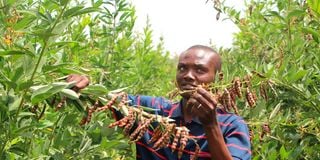New pigeon pea varieties change Ukambani farmers’ fortunes

Stephen Mutunga harvests pigeon peas in Ivinganzia Village, Makueni County on January 12, 2024. Many smallholder farmers in the area have embraced new varieties which mature fast.
What you need to know:
- The early maturing pigeon pea varieties have taken smallholder farmers in the region and the neighbouring Kitui and Machakos counties by storm.
For a long time, Phoebe Mwangangi, a resident of Ngukuni Village in Makueni County, has been waiting for every July to harvest her pigeon peas. The hardy crop, which thrives in semi-arid regions, has been taking almost a year to mature.
But not anymore.
Ms Mwangangi and his neighbours now no longer endure the long wait following the development and uptake of fast maturing pigeon pea varieties as scientists join hands with smallholder farmers to reduce the adverse effects of climate change.
“We no longer have to wait until July to harvest pigeon peas. They are available throughout the year. We use them to make sauces and also mix with maize to form isyo (githeri),” Ms Mwangangi tells Climate Action.
When the model farmer in the sun-baked Makindu region runs out of stock, she joins other pigeon pea lovers in shopping for the commodity in local markets.
The legume is a good source of carbohydrates, proteins, fats and minerals.
The growing demand for pigeon pea keeps countless smallholder farmers in the region vibrant. Stephen Mutunga, a youthful veterinary doctor, is the face of emerging elite farmers who have embraced commercial pigeon pea production.
Mr Mutunga, who was introduced to the business shortly after he graduated from Egerton University, has a 20-acre pigeon pea farm.
“This is M-PESA,” Mr Mutunga says, referring to a high-yielding and fast-maturing variety developed by the International Crops Research Institute for the Semi-Arid Tropics (Icrisat) by its nickname.
“It takes four months to mature,” he adds as he shows Climate Action around the farmland teeming with luxuriant bushes sagging with pods at the sleepy Ivinganzia Village.
Just like many farmers in the region, Mr Mutunga intercrops pigeon peas with maize and beans. Scientists recommend pure stands for maximum yield. “In a pure stand, the spacing is 120 cm from row to row and 50 cm between pigeon pea plants. This way the crop will be able to realise its full potential,” says Rael Karimi, a pigeon pea breeder at the Kenya Agricultural and Livestock Research Organization (Kalro).
Unlike most other pigeon pea farmers in the area, Mr Mutunga irrigates his crop using water drawn from the nearby Athi River. This gives his produce a competitive edge. “We supply green pigeon peas to traders who take them to Mombasa and Nairobi throughout the year. A kilo fetches up to Sh200. It is more profitable to sell pigeon pea when it is green. To ensure that we do not let our customers down, we stagger the planting to have a constant supply. But we cannot meet the demand.”
Ms Karimi, who is based at the Katumani drylands crops research station in Machakos County, is among a team of scientists at Kalro fanning the increased appetite for pigeon peas and other drought-resistant crops in a programme funded by the European Union. Scientists at Kalro have developed ‘Mituki’, the latest early maturing pigeon pea variety in the market, as they advance in the frontline against climate change.
“Previously, farmers have been growing local pigeon pea varieties that take almost a year to mature. You plant in October and harvest the following year in July and August and September. That was taking too long. It also meant harvesting once a year. We have now came up with varieties that take about four months to mature. Those who plant in October are in the market in February and March when the prices are the highest. This is a very good opportunity for farmers because they can harvest twice a year,” Ms Karimi tells Climate Action on the sidelines of a recent farmer’s field day at Kiboko in Makueni County.
The early maturing pigeon pea varieties have taken smallholder farmers in the region and the neighbouring Kitui and Machakos counties by storm.
Farmers who depend on rainfall are able to harvest twice a year; in March and July and August. Others innovatively push the harvesting period to December, January and February through ratooning.
“Once you cut a mature pigeon pea plant and there is adequate moisture, it sprouts and will continue producing flowers and pods. However, we do not encourage prolonged ratooning because it can lead to a build-up of diseases and pests, which can spread to other crops around, calling for use of more pesticides and increasing the cost of production. Farmers should plant afresh every planting season. They should use certified seeds for maximum yield,” Ms Karimi says.
She notes that the new breeds produce up to four tonnes of pigeon pea per hectare. “One plant can produce up to a kilo of dry pigeon peas. However, most of the crop is consumed when green. More than 90 per cent of the pigeon pea produced in the country is consumed when green. This means that the country does not have enough dry pigeon peas to meet the demand in the local and export markets. We should double our efforts,” she adds.
Ms Mwangangi is among smallholder farmers who shoulder the responsibility of increasing the country's pigeon pea yields. She is at the centre of a World Bank-funded programme aimed at accelerating the uptake of climate smart agriculture in semi-arid counties. It entails linking smallholder farmers with scientists. The programme promotes the use of the right varieties of drought-resistant crops such as green grams, millets, cow pea, groundnuts, sorghum and pigeon peas.
It also promotes soil and water conservation technologies such as deep tillage, zai pits, mulching, terraces and farm ponds to boost yields in the wake of erratic rainfall.
Ms Mwangangi also makes indigenous foods such as cake made of sorghum flour, samosas filled with green grams, and special pilau made with cowpeas and sorghum.
“The best way to promote a product is increasing its demand. This is what value addition of indigenous foods through innovative recipes does to indigenous crops, which have been proven to be not only healthy but also friendly to the environment,” says Henry Ojulong, a senior scientist in charge of breeding at the International Crops Research Institute for the Semi-Arid Tropics. He leads a team of scientists working with farmers to accelerate the uptake of climate smart agriculture among smallholder farmers.





